"Up until recently, polarimeters have been pretty large instruments, and depending on the measurement strategy, could involve lots of moving parts and different optics," said Meyer. "This metasurface technology splits the incoming signal into all four states."
Without the moving parts, this technology could enable polarimetry in small satellites like SmallSats and CubeSats but could also be scaled up for use on larger missions at a significant cost, volume, weight and power savings over existing technology.
While the Harvard technology is still in early development, Goddard scientist Dan Miller said a type of polarimeter is expected to fly as part of the NASA's planned Earth System Observatory on the Aerosol, Cloud, Convection and Precipitation (ACCP) mission recommended in the 2017 Earth Decadal Survey.
Expected to go into development this year, this mission would, among other things, combine polarimetry with lidar data to provide new insights into the clouds and particles in the atmosphere and how they affect life on Earth. Lidar means Light Detection and Ranging and it is a remote sensing method that uses light in the form of a pulsed laser to measure variable distances to the Earth.
"The combination of a lidar and a polarimeter in orbit, observing the same target, tells you both what you're looking at and the vertical distribution—where it is in the atmosphere," Miller said.
The partnership gave Harvard postdoctoral researcher Noah Rubin valued insight into the science use cases for his technology.
"Working with our new colleagues at NASA has been great," Rubin said. "My team at Harvard were primarily concerned with new physics and optical technologies enabled by controlling light at the nanoscale. It's rare, however, that we get the chance to interact with potential end-users in such a direct way, not to mention at such an early stage in a new technology's development."
For Earth scientist Ed Nowottnick, the Harvard technology makes distributed observations of clouds and aerosolized particles one step closer to reality.
"I could see flying this sensor in space as a constellation," he said. "If you could put up multiple copies, you can improve your coverage over time. Then, you're really going a long way toward understanding atmospheric processes."
Payouts would include better forecasting of weather, aerosol particles, and clouds, as well as a stronger understanding of how climate change could affect these processes in the future.



